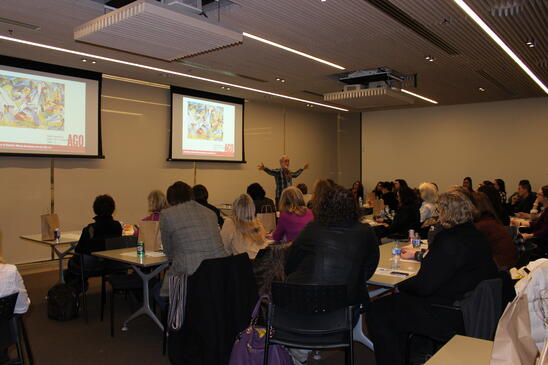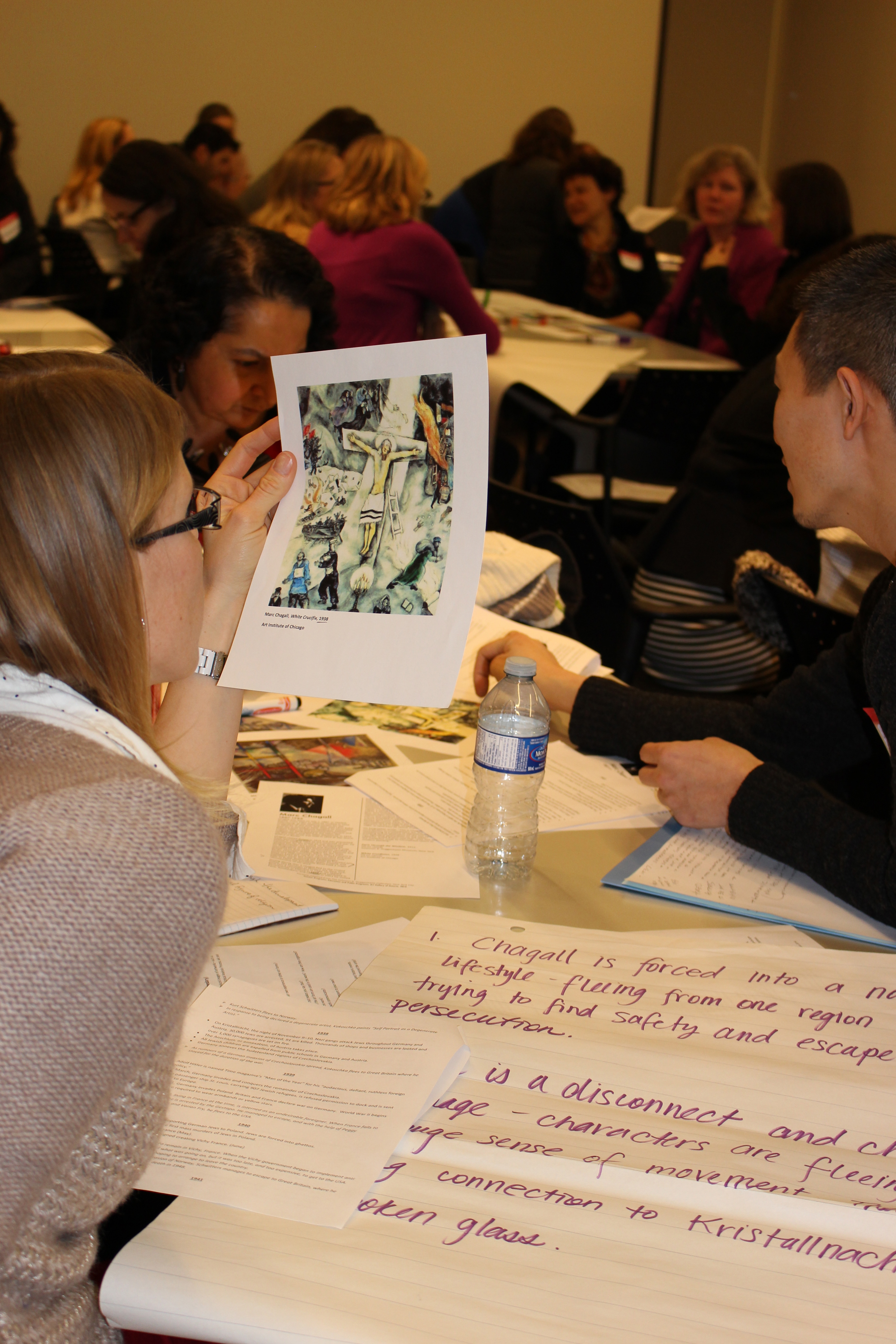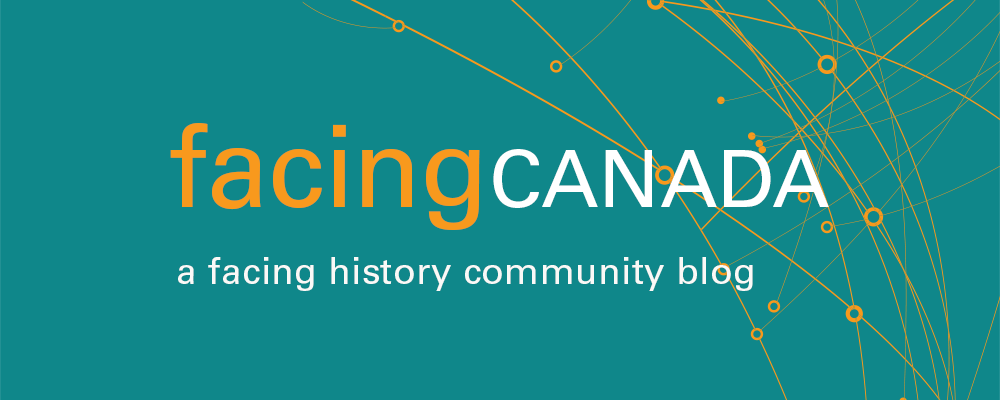Recently, Facing History and Ourselves and the Art Gallery of Ontario co-sponsored a workshop for the exhibit “The Great Upheaval.” This exhibit was on loan from the Guggenheim Collection and focused on European artists during 1910-1918. As a teacher, I was interested in this workshop for two reasons: to learn more about these artists and to discover new strategies to incorporate art into my teaching practice.
The night was launched with an informative lecture by David Wistow who provided us with the context of this time period. For me, he truly brought the period alive. I was aware of the new innovations of the early 20th century and the impact they had but I never really thought about how it altered the auditory landscape, how these new sounds  of the radio, telephone, automobile and airplane pierced the relative quiet of their everyday lives. Wistow also pointed out that due to these new scientific advancements, these innovators were the true pioneers of the first social network (our students won’t be happy to hear this!) As the world became smaller, a new sense of collaboration emerged between these European artists. For students, we can easily make the link from this time period to their own: how has social media transformed their world? Our world? This discussion will enable students to see the similarities between themselves and the past, even if it was 100 years ago.
of the radio, telephone, automobile and airplane pierced the relative quiet of their everyday lives. Wistow also pointed out that due to these new scientific advancements, these innovators were the true pioneers of the first social network (our students won’t be happy to hear this!) As the world became smaller, a new sense of collaboration emerged between these European artists. For students, we can easily make the link from this time period to their own: how has social media transformed their world? Our world? This discussion will enable students to see the similarities between themselves and the past, even if it was 100 years ago.
In response to these new technologies, the artists left behind 500 years of tradition and painted what they saw, what they thought and what they felt. It truly was the beginning of the movement to express one’s psyche.  In “Planes by Colours,” Frantisek Kupka explores the technology of x-rays, Robert Delaunay paints the Eiffel Tower as a symbol of globalization, and Marc Chagall paints his past colliding with the present in “Paris Through the Window.” These stunning pieces provide insight and bring to life the complexities of the time period in ways a textbook simply cannot. This is the value of art in our classrooms – it brings a moment of time alive.
In “Planes by Colours,” Frantisek Kupka explores the technology of x-rays, Robert Delaunay paints the Eiffel Tower as a symbol of globalization, and Marc Chagall paints his past colliding with the present in “Paris Through the Window.” These stunning pieces provide insight and bring to life the complexities of the time period in ways a textbook simply cannot. This is the value of art in our classrooms – it brings a moment of time alive.
After the lecture, we continued in our role as students and explored ways in which we could infuse our classrooms with art. We left 1918 and moved to the rise of the Nazis in 1933. The Nazi regime declared that the artists and their works within The Great Upheaval exhibit were “Degenerate” and their work was banned. We watched a fascinating video by Dr. Jonathan Petropoulous “Degenerate Art and Nazi Propaganda” which set the historical context for this time period while also raising the big question of “constructing obedience.” While watching this film we reflected using the S.I.T. strategy:
What did you find:
Surprising
Interesting
Troubling
After the video, we debriefed in small groups about our SIT – this is a great strategy to provide focus and talking points for students to engage in meaningful conversation.
Leora Schaefer, Director of Facing History and Ourselves Toronto, reminded us that these artists were asking big questions about their society and that is exactly what we want our students to do. In small groups, we were each given a folder with a biography of an artist, a few of their works and a timeline. After we went through the folder, groups were asked to use the Big Paper strategy, a silent conversation between group members that exists on chart paper. We were discussing questions such as “How can samples of the art created by your artist shed light on the time period in which they were created?” I have used this strategy many times and it is fabulous!  It allows everyone to have a voice and gives each student time to reflect on the material; their responses are not reactive but instead insightful. Once the Big Papers were complete, we posted them around the room for a Gallery Walk. Great questions were posed by our facilitators to evoke greater depth and understanding:
It allows everyone to have a voice and gives each student time to reflect on the material; their responses are not reactive but instead insightful. Once the Big Papers were complete, we posted them around the room for a Gallery Walk. Great questions were posed by our facilitators to evoke greater depth and understanding:
What criteria should be used to decide what art is “acceptable” for the public? Who decides? How does art play a role in opening up or shutting down discourse in society?
These questions easily transcend Nazi Germany and can be used when studying different time periods.
What a wonderful way to spend a night! A lecture, analyzing and discussing art with fellow educators, all followed by a walk through the exhibit itself. I was inspired by this workshop and it prompted me to incorporate more art into my teaching practice as a way to engage my students and to keep asking those big questions.
How have you used art in the classroom? What big questions were raised in your class as a result of studying art?

